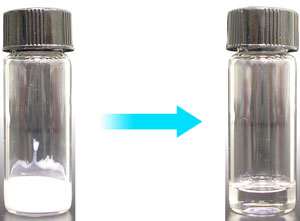| Nov 16, 2012 |
Expanding DNA's utility in nanotechnology
|
|
(Nanowerk News) Carrying the genetic code is already a vital job, but DNA is also proving to be a useful tool in nanotechnology applications. Since the DNA molecule is a versatile building block, it can be used to construct molecular devices. DNA structures known as ‘DNAzymes’ can also act as catalysts for certain chemical reactions. However, the inability to dissolve DNA in anything but water has hindered progress. Now, DNA can be dissolved in a range of organic solvents, without destroying its folded structure, thanks to a discovery by Hiroshi Abe, Yoshihiro Ito and their colleagues at the RIKEN Advanced Science Institute, Wako ("Structure Formation and Catalytic Activity of DNA Dissolved in Organic Solvents").
|
 |
| DNA will usually only dissolve in water. However, by modifying it with a polyethylene glycol (PEG) side chain (left) and adding a typical laboratory organic solvent called 1,2-dichloroethane, the DNA will dissolve (right).
|
|
The researchers showed that DNA will dissolve in most organic solvents after attaching a long side chain called a polyethylene glycol (PEG) unit. Organic solvents are typically much less polar than water, which prevents polar DNA molecules from dissolving in them. By attaching a non-polar PEG group to one end of a DNA strand, they were able to dissolve it in organic solvents ranging from methanol to 1,2-dichloroethane—solvents that scientists usually use for chemical reactions because many molecules are water-sensitive.
|
|
The team used an analytical technique called circular dichroism to show that a series of PEG-modified DNA structures called G-quadruplexes retain their shape in the organic solvents. Other teams had successfully dissolved DNA in an organic solvent by simply pre-mixing it with another non-polar substance, but the process caused the DNA to lose its folded shape, Abe notes. “[The] PEG-modification allows us to keep the structure of DNA intact in organic solvents,” he says.
|
|
Surprisingly, one of the PEG-modified G-quadruplex structures tested by the researchers proved to be more stable in organic solvents than it is in water. While some of the forces that hold the DNA structure in its folded shape are weaker in the non-polar organic solvent, others, such as hydrogen bonding interactions, are strengthened, Abe explains.
|
|
Crucially, the retention of DNA’s structure in organic solvents means that it can also retain its ability to function as a catalyst, for example. In water, the PEG-modified version of a G-quadruplex DNAzyme named HT6 oxidizes a molecule called luminol into a light-emitting form. When the researchers switched to an organic solvent, a tell-tale luminescent glow confirmed that the DNAzyme was still functioning.
|
|
Abe, Ito and colleagues are now focused on generating organic-solvent-soluble DNAzymes with more useful catalytic functions. They are using a technique called SELEX to generate libraries of DNAzymes tailor-made to work in organic solvents.
|

